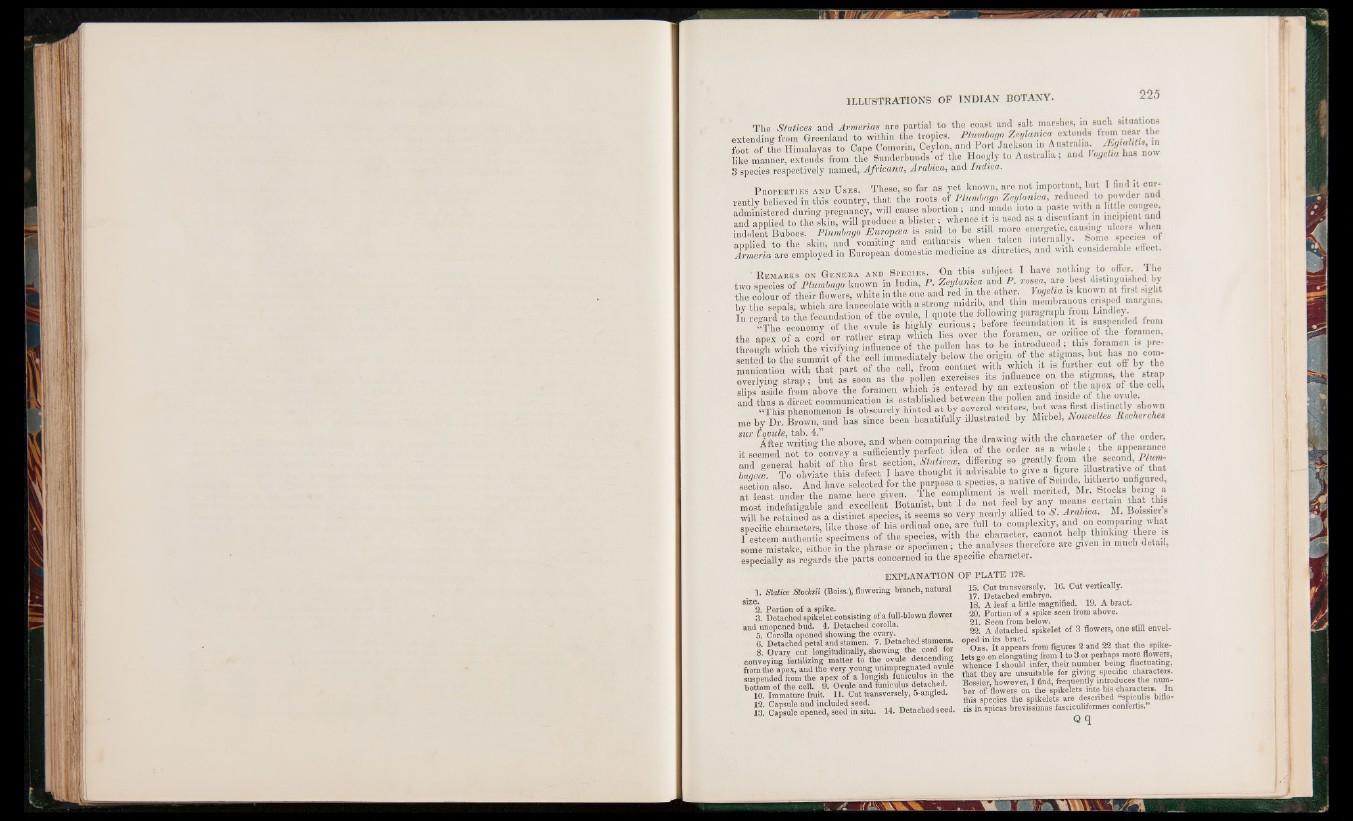
The Statices arid Armerias are partial to the coast and salt marshes, i" e° c^ slt°atl^
extending from Greenland to within the tropics. Plumbago Zeylanica extends horn near'the
foot of the Himalayas to Cape Comorin, Ceylon, and Port Jackson in Australia, jhgiahtis, in
m e manner, eX n T f rom Z Sunderbunds'of the Hoogly to Australia; and Vogelia has now
3 species respectively named, Africana, Arabica, and Inaica.
P r o p e r t ie s a n d U s e s . These, so far as yet known, are not important, but I find it currently
believed in this country, that the roots of Plumbago Zeylanica, ffidueed to powder and
administered during pregnancy, will cause abortion ; and made into a paste with a little congee,
and'applied to the slon^will produce a blister; whence it is used as a discut.ant in incipient and
indolent Buboes. Plumbago Europaa is said to be still more energeticcausmg ulcers when
applied to the skin, and vomiting and catharsis when taken internally. Some species ot
Irmeria are employed in European domestic medicine as diuretics, and with considerable effect.
■ R em a r k s on G e n e r a a n d S p e c ie s . On this subject I have nothing to offer. The
two species of Plumbago known in India, P. Zeylanica and P. rosea, are best distinguished by
the colour of their flowers, white in the one and red in the other. Vogelia is known at first sight
ly the sepals, which are knceolate with a strong midrib and thin membranous er,sped margins.
In regard to the fecundation of the ovule, I quote the following paragraph from Lmdley.
“The economy of the ovule is highly curious; before fecundation it is suspended from
the apex of a cord or rather strap which lies over the foramen, or orifice of the foramen,
through which the vivifying influence of the pollen has to he introduced; this foramen is presented
to the summit o / the cell immediately below the origin of the stigmas, but has no communication
with that part of the cell, from contact with which it is further cut off by the
overlying strap; but as soon as the pollen exercises its influence on the stigmas, the.strap
slips aside from above the foramen which is .entered by an extension of the apex of the cell,
and thus a direct communication is established between the pollen and inside of the °yule-
“This phenomenon is obscurely hinted at by several writers, but was first distinctly shown
me by Dr. Brown, and has since been beautifully illustrated by Mirbel, Noumlles Recherches
mT A X ^w ri& fth e above, and when-comparing the drawing with the character of the order,
it se em e d not to® convey a Efficiently perfect idea of the order as a whole; the appearance
and general habit of the first section, Staticece, differing so greatly from the second, Plum-
bagei To obviate this defect I have thought it advisable to give a figure illustrative of that
section also. And have selected for the purpose a species, a a
at least under the name here given. The compliment is well merited, Mr. stocks being a
most indefatigable and excellent Botanist, but I do not fee by any “ ea”8 «erta^n * £ £ £
will be retained as a distinct species, it seems so very nearly allied to S . Arabica. M. Boissier s
lecific characters, like those of his ordinal one, are full to complexity and on comparing what
IPesteem authentic specimens of the species, with the character, cannot help thinking there is
some mistake, either in the phrase or specimen; the analyses therefore are given in much e 1,
especially as regards the parts concerned in the specific character.
EXPLANATION OF PLATE 178.
1. Statm Stocksii (Boiss.), flowering branch, natural
size.2
. Portion of a spike. „ , a
3. Detached spikelet consisting of a full-blown flower
and unopened bud. 4. Detached corolla.
5. Corolla opened showing the ovary.
6. Detached petal and stamen. 7. Detached stamens.
8. Ovary cut longitudinally, showing the cord for
conveying fertilizing matter to the ovule descending
from the apex, and the very young unimpregnated ovule
suspended from the apex of a longish funiculus in the
bottom of the cell. 9. Ovule and funiculus detached.
10. Immature fruit. 11. Cut transversely, 5-angled.
12. Capsule and included seed. , ,
13. Capsule opened, seed in situ. 14. Detached seed.
15. Cut transversely. 16. Cut vertically.
17. Detached embryo.
18. A leaf a little magnified. 19. A bract.
20. Portion of a spike seen from above.
21. Seen from below.
22. A detached spikelet of 3 flowers, one still enveloped
in its bract. ^
Obs. It appears from figures 2 and 22 that the spike-
lets go on elongating from 1 to 3 or perhaps more flowers,
whence I should infer, their number being fluctuating,
that they are unsuitable for giving specific characters.
Bossier, however, I find, frequently introduces the number
of flowers on the spikelets into his characters. In
this species the spikelets are described “spiculis biflo-
ris in spicas brevissimas fasciculiformes confertis. ’
Q q